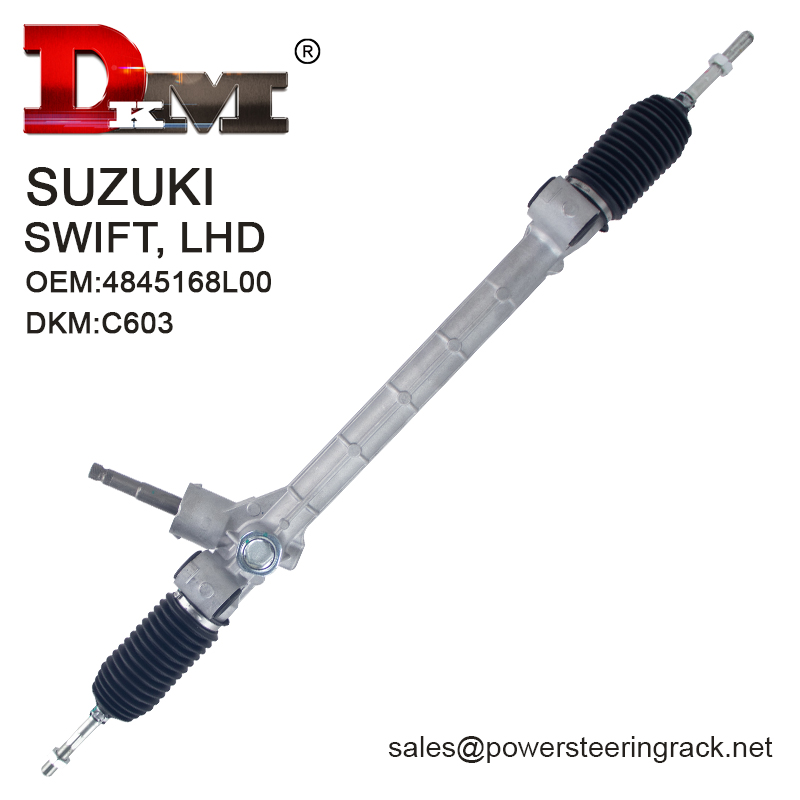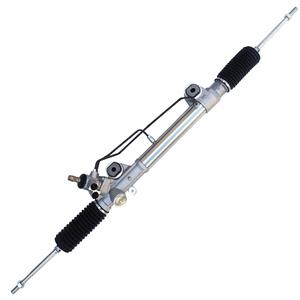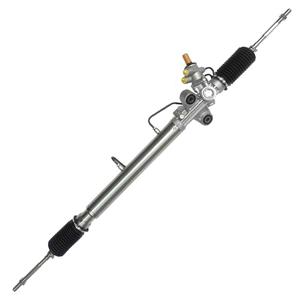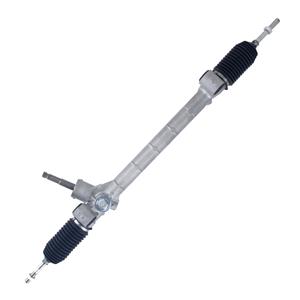What Is A Manual Steering System?
With the rapid development of modern automobile technology, drivers usually rely on various advanced auxiliary systems to improve driving convenience and comfort. Although power steering systems have become standard for most vehicles, manual steering systems still have their unique role and value. The manual steering system is the earliest way of steering a car. It does not rely on any external power, but is operated entirely by the driver's power.
This article will explore in detail the basic principles, composition, advantages and disadvantages of the manual steering system, as well as its important position in the history of automobile development.

What Is A Manual Steering System?
The manual steering system, also known as the power-free steering system, is a mechanical device that relies on the driver to directly apply force to turn the steering wheel and control the steering of the vehicle. Its core lies in converting the rotational motion of the steering wheel into the lateral motion of the wheel through a simple mechanical structure. The manual steering system does not require the use of hydraulic, electric or other external forces. All steering forces are applied entirely by the driver to steer the front wheels through mechanical transmission. This system is the earliest steering technology used in automobile history and is also the simplest and most direct way of steering.
How Does the Manual Steering System Work?
The working principle of the manual steering system is based on gear transmission. The steering wheel is connected to the steering shaft, on which a pinion (usually called a steering gear or pinion rack) is mounted, which meshes with the steering rack (Rack). When the driver turns the steering wheel, the pinion rotates and drives the rack to move linearly in one direction. The movement of the rack directly acts on the steering rod, which in turn controls the angle of the front wheels, thereby achieving the steering of the vehicle.

What Are the Mechanical Structures of the Manual Steering System?
The structure of the manual steering system is relatively simple, and usually includes the following key components:
● Steering wheel: The starting point for the driver to apply force, and the direction of the vehicle is controlled by turning the steering wheel.
● Steering shaft: Connects the steering wheel and the steering gear to transmit the rotational force.
● Steering gear and rack: Convert the rotational motion of the steering wheel into the linear motion of the rack.
● Steering knuckle: Connects the steering rack and the wheel, and adjusts the wheel angle through the tie rod.
● Tie rod: Connects the steering knuckle and the wheel suspension system, and directly acts on the steering of the wheel.
What Are the Characteristics of the Manual Steering System?
Manual steering systems rely on pure mechanical transmission without external auxiliary power, so that the driver can directly feel the road conditions and wheel feedback. This direct mechanical connection allows the driver to control the vehicle more accurately, especially for vehicles that require precise control, such as sports cars.
Secondly, the manual steering system has a simple structure and usually does not have complex electronic or hydraulic components. Therefore, its maintenance cost is low and the failure rate is also low. Manual steering systems are still widely used in scenarios that require high reliability, such as off-road vehicles or old cars.
In addition, a significant disadvantage of manual steering systems is that they require greater force when steering, especially when driving at low speeds or parking. Since there is no external power assistance, the driver must directly overcome the friction between the wheel and the ground, which makes it more laborious to control the vehicle. Therefore, in modern traffic environments, manual steering systems usually only appear on smaller vehicles or special-purpose vehicles.
Finally, the manual steering system provides the driver with a pure driving experience, especially for those who pursue driving experience, this system can better reflect the fun and challenge of driving. The driver can directly feel every movement of the wheel, and then make a more accurate control response.

What Are the Pros and Cons of Manual Steering Systems?
Although the manual steering system has been widely recognized for its simplicity and reliability, it also has some disadvantages that cannot be ignored. The following is an analysis of the main advantages and disadvantages of the manual steering system:
Pros of the Manual Steering System
● Strong mechanical feedback: The manual steering system provides strong mechanical feedback, allowing the driver to perceive more road information, which helps to make quick and accurate driving responses.
● Simple structure and easy maintenance: Since there is no complex auxiliary system, the manual steering system is easier to maintain, has a lower failure rate and is relatively inexpensive.
● Lightweight: Compared with hydraulic or electric power steering systems, manual steering systems are lighter, which helps to reduce the overall weight of the vehicle.
● High reliability: Since there are no electronic components or hydraulic devices, manual steering systems are more reliable in extreme environments.
Cons of the Manual Steering System
● Steering operation is laborious: The manual steering system requires greater force at low speeds, especially when parking or turning at low speed, the driver needs more physical strength to operate the steering wheel.
● Low comfort: Compared with modern power steering systems, manual steering systems have lower driving comfort and are prone to fatigue after long-term driving.
● Weakened market demand: With the popularity of power steering systems, the market demand for manual steering systems has gradually decreased, and they continue to be used only in specific vehicle types or retro models.
Application of Manual Steering Systems in Automobile History
The manual steering system is the earliest automobile steering system, which has appeared as early as the birth of the automobile. In early automobile design, due to the limitations of technology and manufacturing level, the manual steering system was the only viable option. It was not until the mid-20th century that power steering systems were gradually introduced with the development of hydraulic technology and eventually became mainstream.
1. Manual Steering in Early Automobiles
In the early 20th century, automobiles were still in their early stages of development, and manual steering systems were standard for almost all vehicles. At that time, cars were usually bulky and very laborious to drive. The early manual steering system had a very simple structure, usually using helical gear or worm gear systems. Although these systems were simple and reliable, they required the driver to have strong physical strength.
2. Improvements in the Mid-20th Century
With the development of the automobile industry, manual steering systems have gradually been improved. Rack and pinion steering systems began to be widely used during this period, replacing the early helical gear and worm gear systems. The rack and pinion system provides more direct and precise steering control while reducing the operating burden on the driver.
3. The Introduction of Power Steering System
In the 1950s, the introduction of hydraulic power steering system marked a major change in automotive steering technology. The power steering system uses external force to assist the driver in operating the steering wheel, greatly reducing the driving burden. With the popularization of power steering system, manual steering system gradually withdrew from the mainstream market.
4. Application of Modern Manual Steering System
Although power steering system has become mainstream, manual steering system still has a market in certain specific areas. For example, some classic cars and racing cars still use manual steering system to pursue the purest driving experience. In addition, some economical small cars and commercial vehicles continue to use manual steering system to reduce manufacturing costs and maintenance costs.

Technical Evolution of Manual Steering System
Although the manual steering system has a simple structure, it has also undergone several technological changes in its development history. Early manual steering systems used helical gears or worm gears, which transmit steering force through spiral motion. Despite the simple structure, these systems are inefficient and the driver needs to apply a large force to complete the steering.
In the mid-20th century, the rack and pinion system became the mainstream of manual steering systems. This system transmits steering force through the meshing of gears and racks, greatly improving steering efficiency and reducing the operating burden of the driver. The advantages of the rack and pinion system are its directness and precision, which enables the driver to better control the vehicle.
After the popularization of power steering systems, manual steering systems have gradually been marginalized. However, modern manual steering systems have been optimized in design, such as using lightweight materials and improved gear designs to reduce operating resistance and improve durability.
Summary of Manual Steering Systems
As the earliest automobile steering method, although the manual steering system is no longer mainstream in the modern traffic environment, it has played a vital role in the history of automobile development. Its simplicity, reliability and directness make it still have market and value in specific fields. Understanding the manual steering system not only helps us understand the development process of automobile technology, but also allows us to better understand the complexity and advancement of modern automobile steering systems.
Although the power steering system performs well in improving driving comfort and convenience, the manual steering system still represents a pure driving experience. This experience cannot be completely replaced, and it is also the pursuit of driving art by car enthusiasts.




